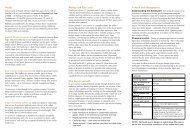Bushland Weeds Manual - Environmental Weeds Action Network
Bushland Weeds Manual - Environmental Weeds Action Network
Bushland Weeds Manual - Environmental Weeds Action Network
Create successful ePaper yourself
Turn your PDF publications into a flip-book with our unique Google optimized e-Paper software.
6<br />
Chapter 2 Managing <strong>Weeds</strong> in <strong>Bushland</strong><br />
Regional information<br />
Australia is divided up into a series of natural regions.<br />
The Swan Coastal Plain and the Wheatbelt are two<br />
such regions within Western Australia from where case<br />
studies in the text have been drawn. An understanding<br />
of a bushland’s natural values in relation to others in<br />
the region provides information on the area’s<br />
significance. For example, a bushland may be<br />
representative of the more common or rare plant<br />
communities in the region. It is important to note that<br />
the rarest communities (Threatened Ecological<br />
Communities) and flora (Declared Rare Flora – DRF),<br />
are protected by laws, either at the state (DRF) or the<br />
federal (communities) level. Bush Forever, Volume 2 –<br />
Directory of Bush Forever Sites (Government of<br />
Western Australia 2000) catalogues information on<br />
regionally significant bushland on the Swan Coastal<br />
Plain. It provides details on the area of the bushland<br />
type that remains uncleared in the region, how much is<br />
in conservation reserves, the quality and condition of<br />
those bushlands, and where similar bushland can be<br />
found. This type of information is important in<br />
providing a focus for weed management work, and in<br />
gaining an understanding of bushland values that<br />
require protection (Keighery et al. 1998).<br />
Note: <strong>Bushland</strong> restoration carried out where rare flora occurs<br />
requires a permit from the Department of Conservation and Land<br />
Management (DCLM).<br />
Developing a weed<br />
management program<br />
Resources for bushland restoration work are generally<br />
limited. It is critical that these resources are carefully<br />
targeted through strategies that prioritise management<br />
actions, based on a knowledge of the bushland area<br />
and the weeds that are impacting on it. Central to<br />
these strategies are a series of principles that are<br />
fundamental to successful weed management. Many of<br />
the case studies throughout this manual demonstrate<br />
the application of these principles:<br />
• Contain the spread of serious weeds and protect<br />
intact bushland. Consider the impacts of serious<br />
weeds on rare flora and rare plant communities.<br />
• Prevent new weed species establishing.<br />
• Consider restoration of degraded edges. Usually<br />
this is of lower priority than protection of good<br />
areas. Often though, degraded edges harbour<br />
serious weeds, providing a source of propagules<br />
that continually disperse into intact areas.<br />
Implementation – taking an<br />
integrated approach<br />
Prevent new weeds from establishing<br />
• Clean tools, boots, equipment and machinery<br />
between jobs to reduce risk of spread<br />
between sites.<br />
• Practise soil hygiene.<br />
• Check paving materials before bringing on to a<br />
site, particularly limestone, for weed seed and<br />
only acquire from accredited clean sources. Black<br />
Flag (Ferraria crispa), Geraldton Carnation Weed<br />
(Euphorbia terracina) and Pretty Betsy<br />
(Centranthus rubra) to name a few have been<br />
introduced to various bushland sites around Perth<br />
in paving materials.<br />
• Avoid bringing soil or mulch from elsewhere into<br />
bushland.<br />
• Know the plants of your bushland (native and<br />
introduced) and immediately remove infestations<br />
of any new weeds. This is important at individual<br />
sites but also at a regional and state level.<br />
See case study 5.2 on Holly-leafed Senecio<br />
(Senecio glastifolius) a recent invader to south west<br />
Western Australia.<br />
Limit the spread of established weeds<br />
• Target small populations in good bush and the<br />
outliers of dense infestations - use the maps<br />
(Box 2.1).<br />
• Keep soil disturbance to a minimum. Disturbance<br />
favours the establishment of many weeds. It brings<br />
buried weed seed to the surface thereby releasing<br />
dormancy, and creates favourable conditions for<br />
the germination of wind dispersed weed seed.<br />
• Avoid working in areas where weeds are actively<br />
shedding seed.<br />
• Post-fire conditions (space, light and high nutrient<br />
availability) often favour establishment of weeds.<br />
Weed control in the season immediately following<br />
fire will prevent seed set in established weeds and<br />
reduce germinating weed seedlings. It will limit the<br />
inevitable spread of many serious bushland weeds<br />
through the post-fire landscape.<br />
See Box 4.2 on fire and cormous and bulbous weeds,<br />
Box 5.1 on the weeds that move in with soil<br />
disturbance, and Box 3.5 on limiting the spread of<br />
Perennial Veldgrass following fire.



